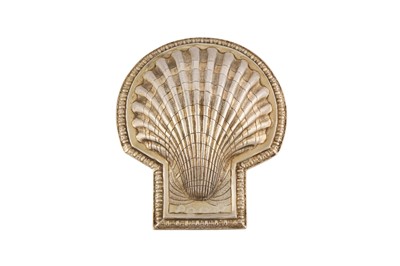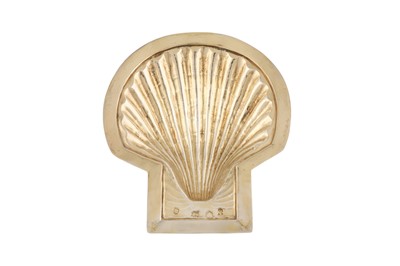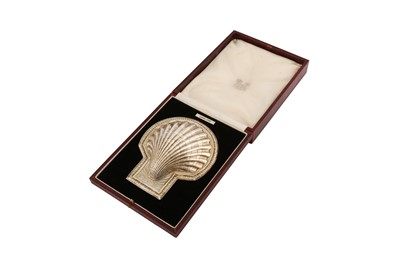23rd Jun, 2022 11:00
Silver & Objects of Vertu
An Elizabeth I sterling silver gilt sugar or spice box lid, London 1598 by a triangle intersected (unidentified)
An Elizabeth I sterling silver gilt sugar or spice box lid, London 1598 by a triangle intersected (unidentified)
Formed as a scallop shell with alternating plain and textured bands, edged with an applied egg and dart border. Fully marked to the reverse edge. Housed in a later fitted Moroccan leather case, branded for S. J. Phillips.
Length – 14.7 cm / 5.75 inches
Weight – 142 grams / 4.57 ozt
Case length – 20.3 cm / 8 inches
The makers mark on this shell, is most similar to the makers mark found upon the famous gilt leopard flagons of 1600, formerly in the Royal Collection when sold by Charles I in 1626 from the 'Great guilt Cubberd of Estate’, then later bought for the Kremlin in 1629, illustrated Sotheby’s, (1991) English Silver Treasures from the Kremlin, p. 152-154. The mark upon the flagons is contained within a triangular form punch whereas on this lot it is in a shaped punch. Jackson also records this mark on an embossed cup. If this mark is an earlier version of the maker using the triangle intersected, the fact that it is found upon the Leopard flagons demonstrates that this must have been a highly important workshop of the late Elizabethan / Jacobean age.
Scallop shell spice boxes are a distinctive form of late 16th / early 17th century London silver, around twenty examples are thought to survive which alongside this lid the earliest known example is the 1598 by the same maker in the Middle Temple Collection illustrated in L. Clowes, “The Rothermere Silver at the Middle Temple,” The Connoisseur, CXXXIX, 1957, p.31 No. 10. The survival rate for domestic silver from this period is especially low as silver was routinely exchanged for newer wares as fashions changed or finances faltered. A plausible reason for the survival of this lid and not it’s box section, where the hinges have been carefully removed, may be that by the middle of the 18th century it had been refashioned to serve as a butter shell, an item of considerable fashion at this time which was actually used to hold seafood dishes; a thrifty Georgian household inadvertently preserving what is now a treasured survival of Elizabethan holloware.
Provenance: Lady Olive Baillie (1899-1974) of Leeds Castle, gifted to her butler Burrett, signed copy of Jackson’s with dedication dated August 2nd 1968 accompanying.
Do you have an item similar to the item above? If so please click the link below to submit a free online valuation request through our website.







